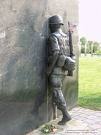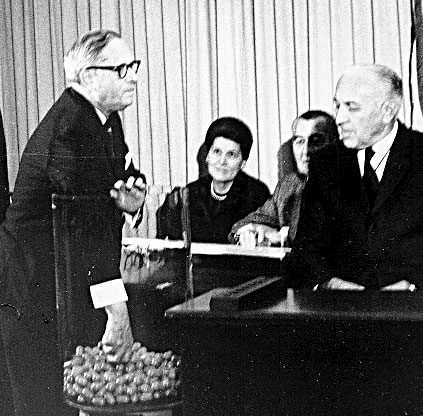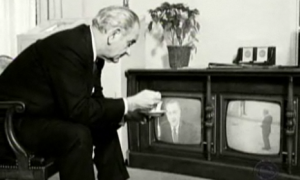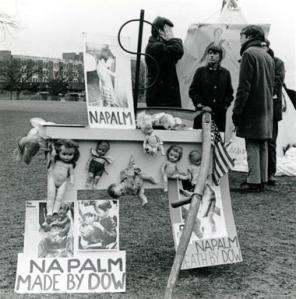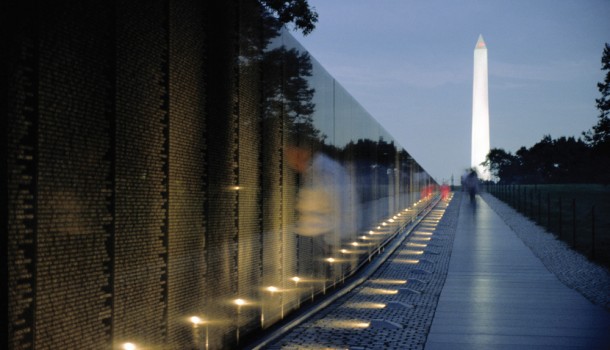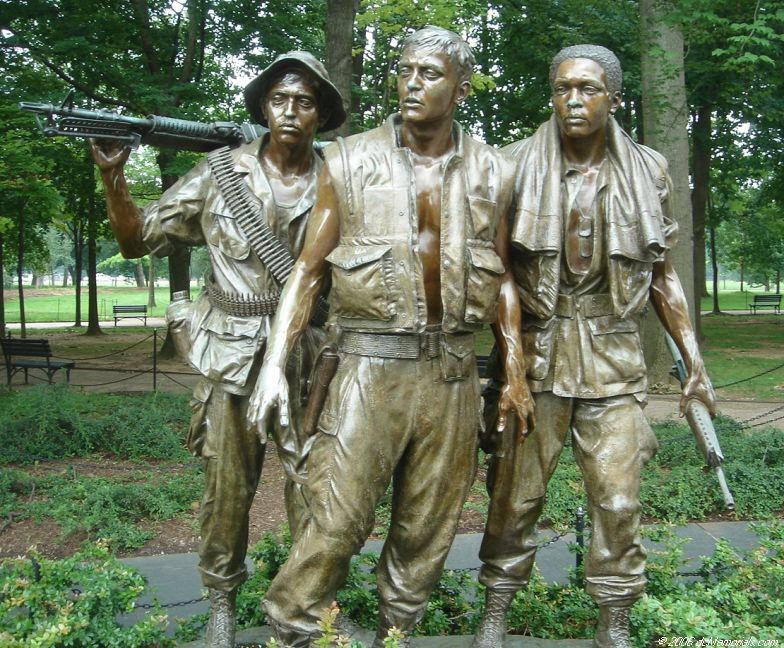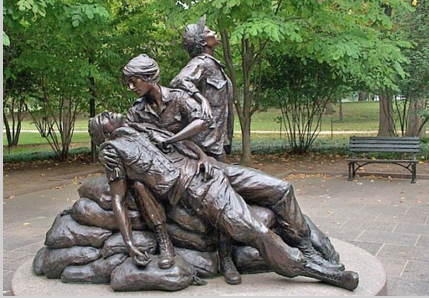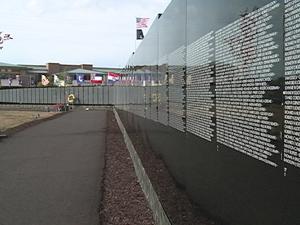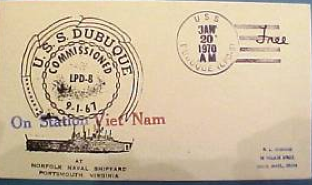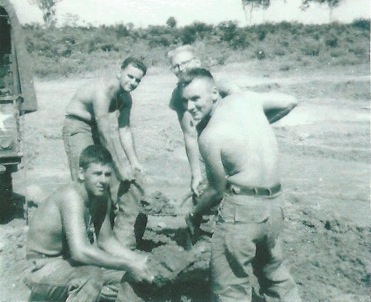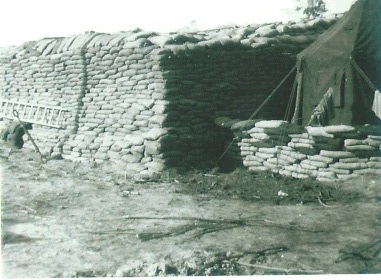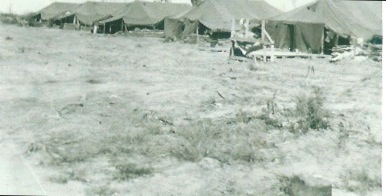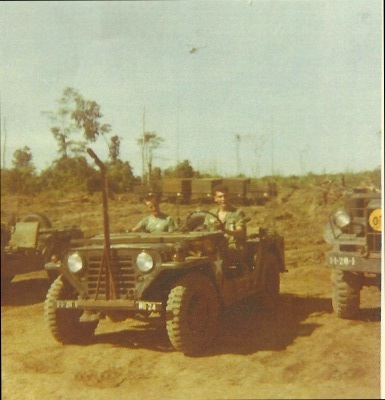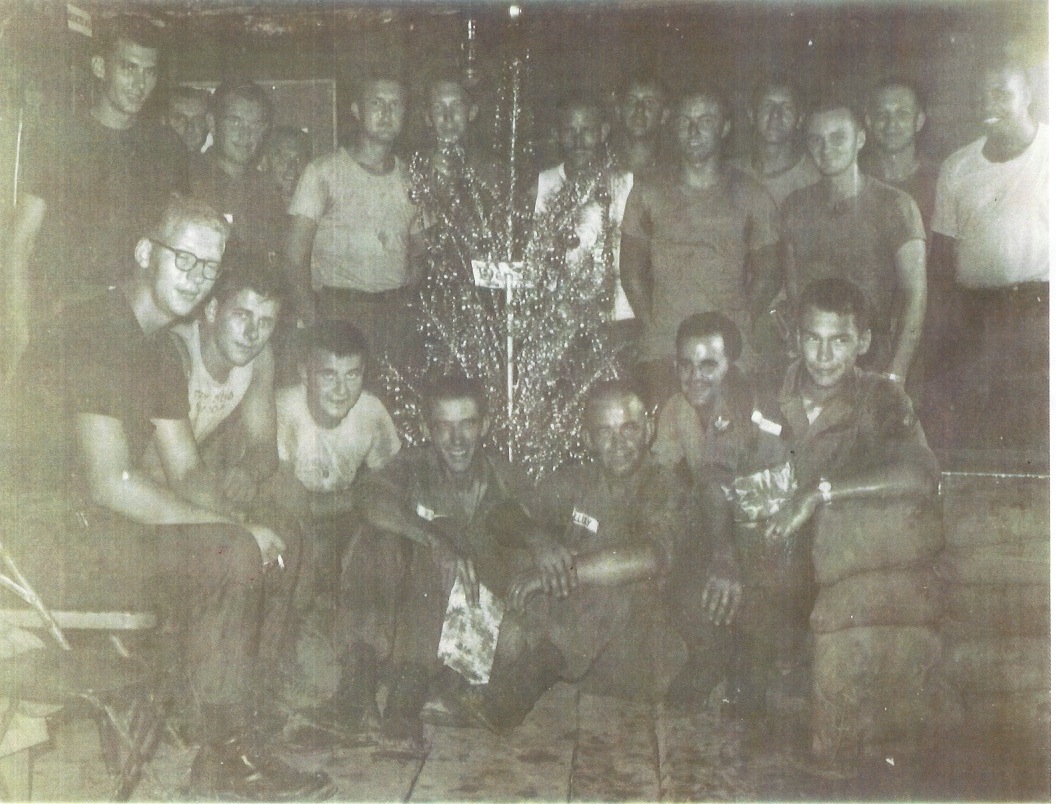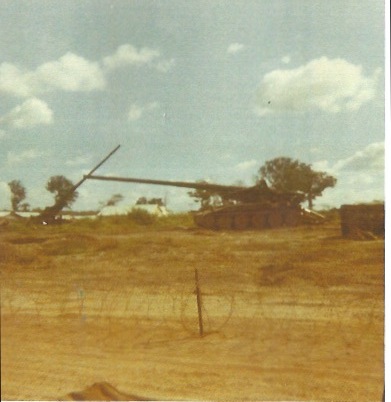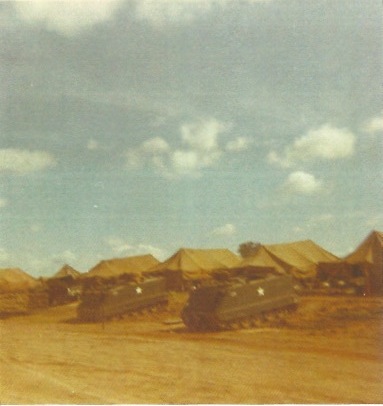Encyclopedia Dubuque
"Encyclopedia Dubuque is the online authority for all things Dubuque, written by the people who know the city best.”
Marshall Cohen—researcher and producer, CNN
Affiliated with the Local History Network of the State Historical Society of Iowa, and the Iowa Museum Association.
VIETNAM WAR
This entry is being edited.
VIETNAM WAR. The Vietnam War was a military action in Southeast Asia in which the United States never formally declared war. United States participation, which began with limited use of American troops as advisers to South Vietnam, reached a peak of over 543,000 troops in February 1969.
Response to the American involvement led to thousands of marches and protests in the United States.
United States involvement ended with a cease-fire agreement signed by the United States, Viet Cong, and North and South Vietnam representatives in January 1973. Returning troops, however, were not welcomed as their predecessors in other wars--a shameful chapter in America's treatment of its military forces.
This entry will not deal with the Vietnam War outside of activities related to Dubuque including efforts to address veterans' issues.
The Vietnam War came to Dubuque and its citizens wherever they were on December 1, 1969 when a lottery drawing - the first since 1942 - at Selective Service National Headquarters in Washington, D.C. This event determined the order of call for induction for registrants born between January 1, 1944, and December 31, 1950. Reinstitution of the lottery was a change from the "draft the oldest man first" method, which had been the determining method for deciding order of call. (1)
There were 366 blue plastic capsules containing birth dates placed in a large glass container and drawn by hand to assign order-of-call numbers to all men within the 18-26 age range specified in Selective Service law. (2)
With radio, film, and TV coverage, the capsules were drawn from the container, opened, and the dates inside posted in order. The first capsule - drawn by Congressman Alexander Pirnie (R-NY) of the House Armed Services Committee - contained the date September 14, so all men born on September 14 in any year between 1944 and 1950 were assigned lottery number 1. The drawing continued until all days of the year had been paired with sequence numbers. (3) People with low lottery numbers received their draft notices within a week. (4)
| Table | Date of Drawing | Applied to Year of Birth | Admin. Processing Number (5) |
|---|---|---|---|
| 1970 | 1-Dec-69 | 1944-1950 | 195 |
| 1971 | 1-Jul-70 | 1951 | 125 |
| 1972 | 5-Aug-71 | 1952 | 95 |
| 1973 | 2-Feb-72 | 1953 | 95 |
| 1974 | 8-Mar-73 | 1954 | 95 |
| 1975 | 20-Mar-74 | 1955 | 95 |
| 1976 | 12-Mar-75 | 1956 | 95 |
The Administrative Processing Number (APN) indicated the highest lottery numbers called for each table year. The APN (highest number) called for a physical was 215 for tables 1970 through 1976.
The order of selection from among men born on the same date was determined by the order in which the first letters of their last, first, and middle names were drawn. For example, for Mr. Robert Brown, the alphabetical random selection sequence number for “B” is 25 and “R” is 23.
Alphabetical Sequence Table (6)
| Number | Letter |
|---|---|
| 1 | J |
| 2 | G |
| 3 | D |
| 4 | X |
| 5 | N |
| 6 | O |
| 7 | Z |
| 8 | T |
| 9 | W |
| 10 | P |
| 11 | Q |
| 12 | Y |
| 13 | U |
| 14 | C |
| 15 | F |
| 16 | I |
| 17 | K |
| 18 | H |
| 19 | S |
| 20 | L |
| 21 | M |
| 22 | A |
| 23 | R |
| 24 | E |
| 25 | B |
| 26 | V |
Results of the 1970 Lottery Drawing (7)
| Jan. | Feb. | Mar. | Apr. | May | June | July | Aug. | Sept. | Oct. | Nov. | Dec. | |
|---|---|---|---|---|---|---|---|---|---|---|---|---|
| 1 | 305 | 86 | 108 | 32 | 330 | 249 | 093 | 111 | 225 | 359 | 019 | 129 |
| 2 | 159 | 144 | 29 | 271 | 298 | 228 | 350 | 045 | 161 | 125 | 034 | 328 |
| 3 | 251 | 297 | 267 | 083 | 40 | 301 | 115 | 261 | 049 | 244 | 348 | 157 |
| 4 | 215 | 210 | 275 | 081 | 276 | 020 | 279 | 145 | 232 | 202 | 266 | 165 |
| 5 | 101 | 214 | 293 | 269 | 364 | 28 | 188 | 054 | 082 | 024 | 310 | 056 |
| 6 | 224 | 347 | 139 | 253 | 155 | 110 | 327 | 114 | 006 | 087 | 076 | 010 |
| 7 | 306 | 91 | 122 | 147 | 35 | 085 | 050 | 168 | 008 | 234 | 051 | 012 |
| 8 | 199 | 181 | 213 | 312 | 321 | 366 | 013 | 048 | 184 | 283 | 097 | 105 |
| 9 | 194 | 338 | 317 | 219 | 197 | 335 | 277 | 106 | 263 | 342 | 080 | 043 |
| 10 | 325 | 216 | 323 | 218 | 65 | 206 | 284 | 021 | 071 | 220 | 282 | 041 |
| 11 | 329 | 150 | 136 | 14 | 37 | 134 | 248 | 324 | 158 | 237 | 046 | 039 |
| 12 | 221 | 68 | 300 | 346 | 133 | 272 | 015 | 142 | 242 | 072 | 066 | 314 |
| 13 | 318 | 152 | 259 | 124 | 295 | 069 | 042 | 307 | 175 | 138 | 126 | 163 |
| 14 | 238 | 4 | 354 | 231 | 178 | 356 | 331 | 198 | 001 | 294 | 017 | 26 |
| 15 | 17 | 89 | 169 | 273 | 130 | 180 | 322 | 102 | 113 | 171 | 131 | 320 |
| 16 | 121 | 212 | 166 | 148 | 55 | 274 | 120 | 044 | 207 | 254 | 107 | 96 |
| 17 | 235 | 189 | 33 | 260 | 112 | 073 | 098 | 154 | 255 | 288 | 143 | 304 |
| 18 | 140 | 292 | 332 | 90 | 278 | 341 | 190 | 141 | 246 | 005 | 146 | 128 |
| 19 | 58 | 25 | 200 | 336 | 75 | 104 | 227 | 311 | 177 | 241 | 203 | 240 |
| 20 | 280 | 032 | 239 | 345 | 183 | 360 | 187 | 344 | 063 | 192 | 185 | 135 |
| 21 | 186 | 363 | 334 | 062 | 250 | 060 | 027 | 291 | 204 | 243 | 156 | 070 |
| 22 | 337 | 290 | 265 | 316 | 326 | 247 | 153 | 339 | 160 | 117 | 009 | 053 |
| 23 | 118 | 057 | 256 | 252 | 319 | 109 | 172 | 116 | 119 | 201 | 182 | 162 |
| 24 | 059 | 236 | 258 | 002 | 31 | 358 | 023 | 036 | 195 | 196 | 230 | 095 |
| 25 | 52 | 179 | 343 | 351 | 36 | 137 | 067 | 286 | 149 | 176 | 132 | 084 |
| 26 | 92 | 364 | 170 | 340 | 357 | 022 | 303 | 245 | 018 | 007 | 309 | 173 |
| 27 | 355 | 205 | 268 | 74 | 296 | 64 | 289 | 352 | 233 | 264 | 047 | 078 |
| 28 | 077 | 299 | 223 | 262 | 308 | 222 | 088 | 167 | 257 | 094 | 281 | 123 |
| 29 | 349 | 285 | 362 | 191 | 226 | 353 | 270 | 061 | 151 | 229 | 099 | 016 |
| 30 | 164 | 217 | 208 | 103 | 209 | 287 | 333 | 315 | 038 | 174 | 003 | |
| 31 | 211 | 030 | 313 | 193 | 011 | 079 | 100 |
Each table shows all the birth dates in a given year and the lottery numbers assigned to those dates.
In the first column, on the far left, are the dates of the month. The numbers in the center represent lottery numbers. The table is set up to show the random selection sequence, by month and day.
The last draft call was on December 7, 1972, and the authority to induct expired on June 30, 1973. The date of the last drawing for the lottery was on March 12, 1975. Registration with the Selective Service System was suspended on April 1, 1975, and registrant processing was suspended on January 27, 1976. (8)
For those with birthdays drawn in the upper portion of the lottery list -- April 24, Dec. 30, Feb. 14, Oct. 18, Sept. 6, Oct. 26, Sept. 7, Nov. 22 and Dec. 6 rounded out the top 10 -- the uncertainty over their draft status has ended. They knew they would be drafted early in the year unless they volunteered first. Those at the bottom knew they would not be drafted and could plan their lives. For those in the middle of the drawing, uncertainty still existed.
They would have had a maximum of seven years of uncertainty under the old system of drafting first the oldest available men aged 19 through 25. The estimated 850,000 who were 19 through 25 and classified 1-A or draft eligible as of Jan. 1 were directly affected by the drawing. After the first year, only men 19 at the beginning of the year and older men with deferments which have expired would be affected by the annual lotteries. For men in the 19-25 pool with college or other deferments, the position their birthdays were drawn determined their liability in the year their deferments expired. (9)
Protests Against the War
Iowans who were accustomed to eating dinner while watching the news saw the horror of war. Televised nightly, the pictures of death and dying came to quickly affect viewers:
I was thirteen years old in 1968, growing up in a town
of about 30,000 in Iowa. At the end of 1968 an antiwar
committee formed in town and I joined a small group of
people who organized local demonstrations for the fall
1969 moratoriums and beyond. That’s an example of how
deeply into the heartland of America the antiwar movement
reached. It was not an elitist, isolated, bi-coastal, college
campus phenomenon like some people try to portray—it bubbled
up in the cornfields of Iowa and the wheat fields of Kansas.
There were factory workers and farmers for peace, as well as
students and freaks. (10)
On February 27, 1968, Dubuque residents who were viewers of the "Nightly News With Walter Cronkite," witnessed a watershed moment in news media. The non-political Cronkite, considered the dean of television reporters, stated:
To say that we are closer to victory today is to
believe, in the face of the evidence, the optimists
who have been wrong in the past. To suggest we are
on the edge of defeat is to yield to unreasonable
pessimism. To say that we are mired in stalemate
seems the only realistic, yet unsatisfactory,
conclusion. On the off chance that military and
political analysts are right, in the next few months
we must test the enemy’s intentions, in case this
is indeed his last big gasp before negotiations.
But it is increasingly clear to this reporter that
the only rational way out then will be to negotiate,
not as victors, but as an honorable people who lived
up to their pledge to defend democracy, and did the
best they could. (11)
President Lyndon Johnson, watching live in the White House, reportedly turned to aides and said, “If I’ve lost Cronkite, I’ve lost Middle America.” Although the communist TET Offensive had been defeated, the public optimism of United States government and military officials about the progress of the Vietnam War did not meet the realities seen by the American public. (12)
On April 30, 1970 President Richard Nixon announced that United States forces would invade Cambodia because of the recent communist coup. Students around the country protested this escalation of the Vietnam War. On May 4, 1970 National Guard fired on students at Kent State University, in Ohio killing 4 and wounding 9 people. (13) College protests against the war led to the early closing of the three Iowa universities which sent students home before final examinations. (14)
The military's use of napalm, manufactured by Dow Chemical, was one incident that turned many in the public from criticizing only the politicians into critics of the military with terrible consequences to the troops who returned home to rejection.
The schools of Dubuque have always been well represented at the University of Iowa. Some students from Dubuque were no doubt aware that the 1970 University of Iowa yearbook included many pictures of the men and women who chose to serve the country as members of the Reserved Officers Training Corps (ROTC). Their presence on campus and the academic credit they received for their service was called into question by both students and faculty in the spring of 1970, but university President Willard Boyd said he could not abolish ROTC. The Alumni Review had an article called “ROTC: Alive and Well at Iowa” in the December 1969 issue. (15)
Protest Song (Eve of Destruction) and Pictures--http://wn.com/vietnam_protest_video
War
The USS DUBUQUE was commissioned on September 1, 1967, at Norfolk Naval Shipyard in Portsmouth, Virginia. In November 1967, the ship arrived at its first home port of San Diego, California after passing through the Panama Canal. From 1968 to 1975, DUBUQUE made five Western Pacific deployments that saw extensive duty in Vietnam. In a highly publicized event in October 1968, the ship returned fourteen repatriated prisoners of war to North Vietnam. (16)
From 1969 to 1971, the ship conducted ten KEYSTONE CARDINAL troop lifts to Okinawa as part of the "Vietnamization" of the war. From February to June 1973, the ship operated helicopters that conducted mine clearance operations in Haiphong Harbor. In April 1975, the ship participated in the evacuation of Saigon and the rescue of refugees fleeing South Vietnam. (17)
In mid-1971, the publication of the first Pentagon Papers–which revealed previously confidential details about the war’s conduct–caused more and more Americans to question the accountability of the U.S. government and military establishments. In response to a strong anti-war mandate, Nixon announced the effective end to U.S. involvement in Southeast Asia in January 1973. (18)
According to the National Archives, the following lists those from Dubuque who died in Vietnam. (Name, Rank, Branch of Service, City, Date of Death, Location, Date of Birth)
Gerald Thomas ATKINSON SP4 ARMY DUBUQUE IA 12MAR70 S.VIETNAM 13JUN46 HOSTILE, KILLED
Roy Roger BLEWETT PFC ARMY DUBUQUE IA 05NOV66 S.VIETNAM 07AUG43 HOSTILE, KILLED
Daniel H. CHATFIELD SP4 ARMY DUBUQUE IA 16MAY68 S.VIETNAM 08JUN47 HOSTILE, DIED-WOUNDS
Michael Joseph CLEMENS HN NAVY DUBUQUE IA 09JAN67 S.VIETNAM 03JAN47 HOSTILE, KILLED
Peter Everett COOK PFC MARINES DUBUQUE IA 22APR67 S.VIETNAM 26FEB48 HOSTILE, DIED-WOUNDS
Michael FITZGERALD HN NAVY DUBUQUE, IA 31JAN68 S. VIETNAM 13SEPT45 HOSTILE DIED-WOUNDS
Lawrence Archie HILKIN PFC ARMY DUBUQUE IA 06APR69 S.VIETNAM 16JUN50 HOSTILE, KILLED
William Owen JUERGENS LCPL MARINES DUBUQUE IA 08SEP66 S.VIETNAM 18SEP45 HOSTILE, KILLED
John Patrick MELOY SP4 ARMY DUBUQUE IA 10DEC68 S.VIETNAM 22AUG48 HOSTILE, KILLED
Ronald William MEYER 2LT MARINES DUBUQUE IA 16JUN66 S.VIETNAM 08NOV42 HOSTILE, KILLED
Ellas Louis Mihalakis SGT ARMY DUBUQUE IA 09JUL68 S.VIETNAM 20JUL47 HOSTILE, KILLED
Charles Louis Meyers, Jr. SGT ARMY DUBUQUE IA 21JUL68 S.VIETNAM 07APR45 HOSTILE, KILLED
Carl Anthony "Tony" PALEN SP6 ARMY DUBUQUE IA 22AUG78 S.VIETNAM 11APR47 NON-HOS. DIED-MISS.
James Conrad POWERS CAPT ARMY DUBUQUE IA 26MAY67 S.VIETNAM 23APR40 HOSTILE, KILLED
John Kenneth SCHMITT, Jr. CPL ARMY DUBUQUE IA 11AUG68 S.VIETNAM 19MAR48 HOSTILE, KILLED
Richard E. SUTHERLAND HN NAVY DUBUQUE IA 21SEP67 S.VIETNAM 24JUN45 HOSTILE, KILLED
Remembering
The Vietnam Veterans Memorial Fund was established in 1979 to raise money for the construction of a memorial to the veterans of the Vietnam War. In 1980, Congress allotted three acres near the Lincoln Memorial for the site of this memorial, and a design competition was held. Maya Ying Lin’s design was selected in 1981. Construction began in March 1982 and the Vietnam Veterans Memorial Wall was dedicated on November 13, 1982. The “wall” is actually made up of two identical walls that are each 246 feet and 9 inches long, and contain more than 58,000 names. According to the National Park Service, the memorial receives roughly 3 million visitors per year. (19)
More than 275,000 Americans contributed almost $9 million to the Vietnam Veterans Memorial Fund for the construction of the memorial. Nine groups of names have been added to the Memorial Wall since it was dedicated, with the most recent coming in 2011. The names are listed on the Wall in chronological order, based on the date of casualty. Within each day, the names are listed in alphabetic order. The names were inscribed on the Wall via a computerized typesetting process called photo stencil gritblasting. (20)
The Three Servicemen statue was born out of a controversy surrounding Maya Lin’s design of the Vietnam Veterans Memorial. Some veterans and politicians felt that The Wall was a “giant tombstone,” also referring to it as a “black gash of shame.” For many, it was too abstract a design and people searched for a more heroic, traditional depiction of those who served. As a compromise, it was decided that a statue would be added as a fundamental part of the Vietnam Veterans Memorial. Frederick Hart was selected to create the representational sculpture that would pay homage to our veterans. (21)
On Oct. 13, 1982, the U.S. Commission of Fine Arts unanimously accepted the proposed sculpture. The Statue depicts three soldiers, purposefully identifiable as Caucasian, African-American, and Hispanic-American. Hart stated, “You are supposed to see three soldiers, but there are a lot of things I want you to feel as well. I want you to see that these are very young people. I want you to feel that they bore an excruciating burden.” (22)
The Three Servicemen Statue was unveiled on Veterans Day in 1984, two years after The Wall’s completion. A flagpole that flies the American flag 24 hours a day was dedicated at the same time. At the base of the flagstaff are the seals of the five military services, with the following inscription: “This flag represents the service rendered to our country by the veterans of the Vietnam War. The flag affirms the principles of freedom for which they fought and their pride in having served under difficult circumstances.” (23)
The Vietnam Women’s Memorial was designed by Glenna Goodacre and was dedicated in 1993. (24) Each Memorial Day and Veterans Day, the stories of the women cast in bronze come to life as veterans and other American patriots share their experiences “in their own voices.” Through verse, prose and music, a tapestry of stories is woven by women who served in support of the Armed Forces: nurses, administrators, air traffic controllers, journalists, women who entertained troops as members of the USO and Red Cross, women who served in a variety of occupations around the world. Men who knew their sisters in war and have partnered with them to ensure healing and peace also share their stories in a compelling and educational way. (25)
Senator Tom Harkin, a Navy veteran, was a leader in the Senate in calling on the Department of Defense to improve the process for issuing military medals. In 1999 Harkin added an amendment to the Defense Authorization bill which directed the Secretary of Defense to eliminate the backlog in decoration requests. In 2003 Harkin announced that Richard (Rick) Crimmins of Dubuque was granted eight medals earned during his Vietnam War service with the U.S. Army. Crimmins served in the U.S. Army from 1968 to 1978. He was awarded the Bronze Star Medal, the Army Commendation Medal, the Good Conduct Medal, the National Defense Service Medal, the Vietnam Service medal with three Bronze Service Stars, the Combat Medical Badge 1st Award, the Republic of Vietnam Campaign Ribbon with Device (1960), and the Expert Badge with Auto Rifle Bar. (26)
The Moving Wall, a memorial for Vietnam veterans and those who fought and fell in the war, came to the Port of Dubuque for a second time in 2012. (27)
James Wagner, a co-founder of the VETERANS' FREEDOM CENTER in Dubuque and a veteran of the Vietnam War, said this will be a powerful display"
I think you're going to see a lot of
different emotions from the Vietnam
veterans. "It's been 15 years since
[the traveling wall has] been here,
and I think at that time a lot of the
Vietnam veterans weren't quite ready
to see it, and I think you'll see a
lot more this time."
The wall cost $4,500 to bring to Dubuque. Area businesses donated other necessary materials, such as the temporary sidewalk at the display, plus lighting and tents at the site. (28)
From across the United States, members of the United States Army’s 765th Security Platoon who served in the Vietnam War, were together for a reunion in Dubuque on May 13, 2014. It was the first time many have seen each other since they left Vietnam. The Army’s records of their battalion somehow disappeared. Many of them never expected to reunite. (29)
In December 2014 American Legion Post 6 recognized National POW/MIA Day and honored Carl Anthony "Tony" PALEN, a Dubuque MIA from the Vietnam War. Elaine Palen, of Dubuque, has led efforts to positively identify her brother-in-law's remains. (30)
The University of Dubuque (UD) commitment to service-members and veterans dates to WORLD WAR II with the Navy’s V5/V12 programs, continuing to the present day with an Army ROTC Eagle Detachment, and a veteran support group for those studying on campus. Since 1999, the University encouraged Department of Defense Dependent Schools (DoDDS) graduates living overseas to join our community. The University of Dubuque has been given a “Military Friendly” rating by GI Jobs magazine, is a Yellow Ribbon School, a Vietnam War Commemoration Partner, and a Homebase Iowa employer. The University also employs faculty and staff throughout the campus community, who are veterans of all military branches.
In 2014 the University of Dubuque offered the following assistance, education benefits, and veteran programs to all active duty military, veterans, and their families:
A retired veteran is on-site, providing all student veterans one-on-one
assistance to ensure they are receiving all of their entitled benefits.
Serving our student veterans with one of the largest Veteran Centers in
the region (study rooms, computers, WIFI, media hub, gaming systems,
lounge, and kitchen)
The University of Dubuque participates in the Yellow Ribbon GI Education
Enhancement Program. The University of Dubuque currently contributes
$10,000 (one of the highest in the area) towards the Yellow Ribbon program.
The Veterans Administration matches that amount for a total of $20,000
towards tuition.
Waive the college application fee for veterans relocating to the area
DoDDS Partnership and MCEI Grant (Military Child Education Initiative)
– $3,000
ROTC Service (Contracted Cadets) – $6,000
Army ROTC detachment
Offers a reduced rate for LIFE (Accelerated Adult learning Program)
Federal Tuition Assistance rate.
Credit for Military service through Veterans Joint Service Transcript
(JST).
Acceptance of CLEP/DANTES exams for college credit
Montgomery GI Bill - Active Duty (Chapter 30)
Montgomery GI Bill - Selected Reserve (Chapter 1606)
Post-9/11 GI Bill (Chapter 33)
Survivors and Dependents Educational Assistance Program (Chapter 35)
Reserve Educational Assistance Program (Chapter 1607)
Vocational Rehabilitation - Veterans with Disabilities (Chapter 31) (31)
See category: WALK OF HONOR
See entries: HALLIBURTON, Louise Herron, NAUGHTON, Peggy, SILENT VIGIL FOR PEACE and many others.
The following pictures taken during the Vietnam War were provided by Jim Lang.


